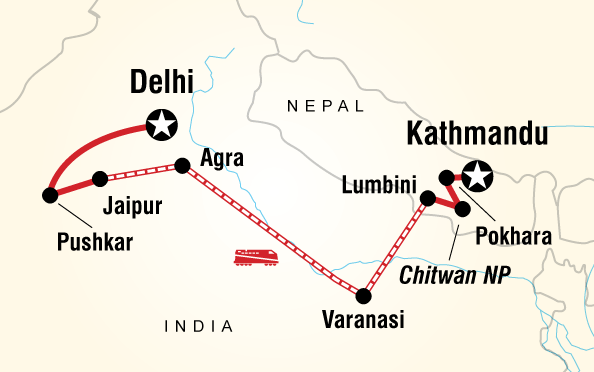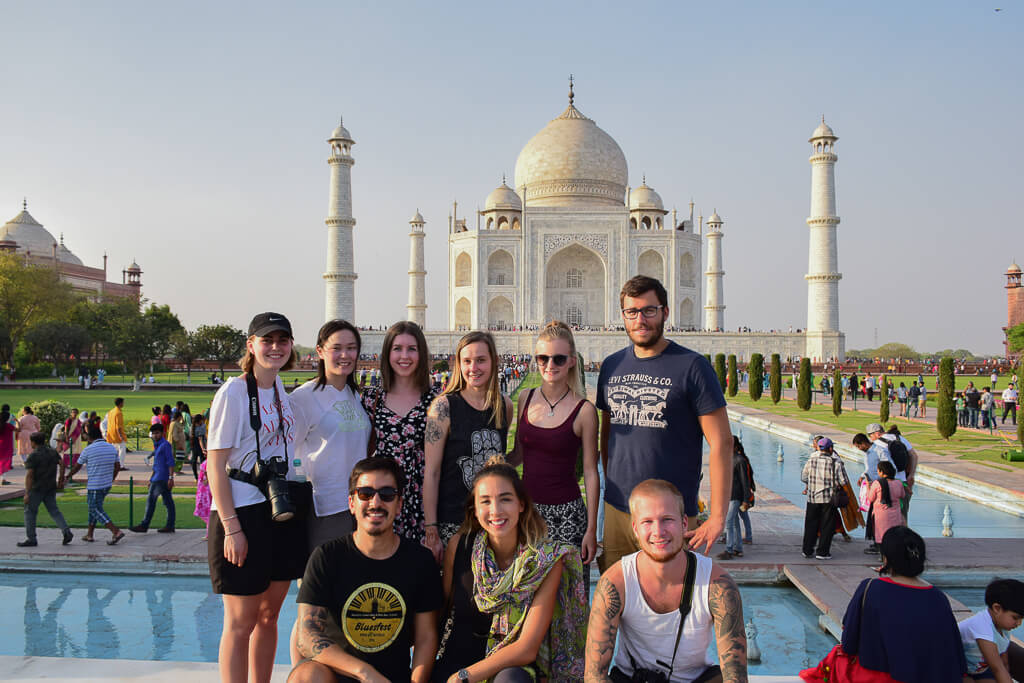Our G Adventures Tour: Delhi to Pokhara
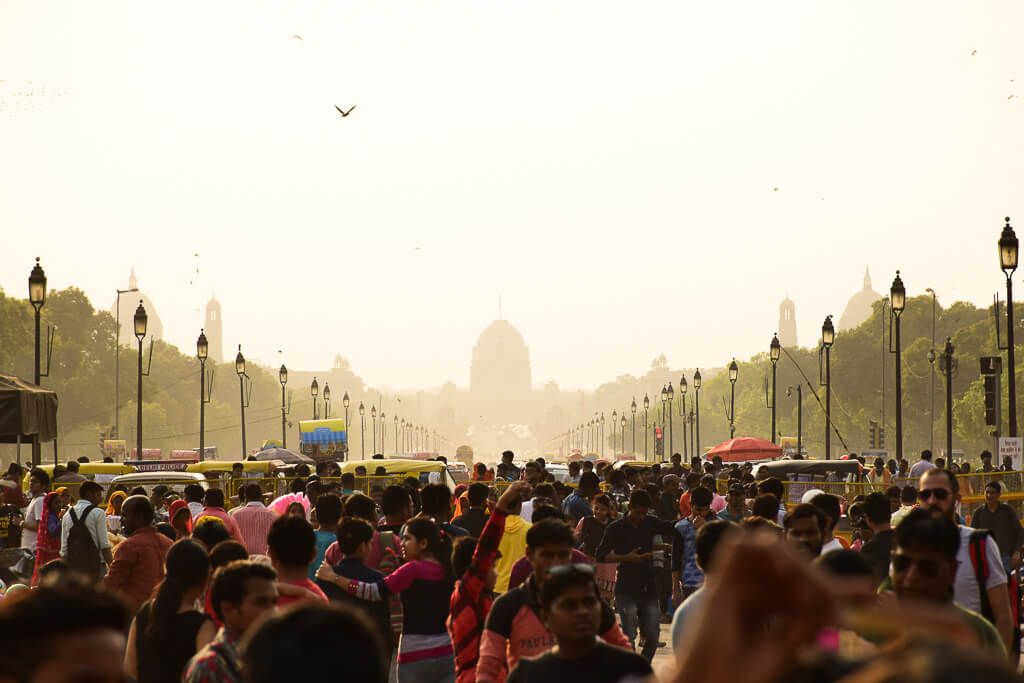
15 days, 9 cities, 2 countries. 18 people, 5 train rides, 3 bus rides, 1 visit to the doctor and a total of 41h travelling (yep, I’m keeping a log).
Our Delhi to Kathmandu tour with G Adventures had a bit of everything - overnight trains, massive traffic jams, a dodgy border crossing, food poisoning, beautiful sunrises, rhinos, elephants and a few crazy nights out with the locals.
We kicked it off at a questionable hotel in Delhi, where we met the group that we’d be with for the next 15 days. Being a “YOLO” style tour (meaning, it only takes 18-30 year olds), the group turned out to be a pleasant surprise - a good mix of boys and girls of varying ages, coming from Norway, Denmark, the UK, Germany, Austria, New Zealand and a few other Aussies.
We chose to do this tour reasoning that India is a difficult country to navigate and it would be easier to be looked after and shown the sights along the way in a safe and comfortable environment. After our week in Rajasthan, however, we felt like we were just getting into the swing of things and questioning if we needed to be on a tour after all. Looking back now, we both have no regrets as we have seen and done things that we would not have had the courage and/or knowledge to do on our own.
The last 15 days were jam-packed with travelling, sightseeing, meals, tours, drinks and occasional visits to the doctors by the majority of the group. Below is our experience on how this tour went.
India Leg:
Delhi > Pushkar > Jaipur > Agra > Varanasi (20 - 28 Mar)
Delhi
After the beauty and (relative) calm of Rajasthan, it’s safe to say Delhi was an overwhelming experience for the both of us and was probably the least favourite place we visited in India. Traffic is as crazy as people warn: standstill’s with honking from all angles, cows roaming/sleeping on the street, motorbikes weaving their way through, cars going the wrong way, it’s madness. Also, after the ease and leisure of walking wherever we needed in the previous cities, having to take a 40 min tuk tuk to get just about anywhere was a hard adjustment. Having said that, we enjoyed some delicious food in Delhi and a hot, but fascinating walk through Old Delhi (the extreme sensory experience of the spice market is not to be missed). We also visited Gurudwara Bangla Sahbi (the largest Sikh temple in Delhi), which was a beautiful experience and eye opening for me as I didn’t know a lot about the Sikh religion.
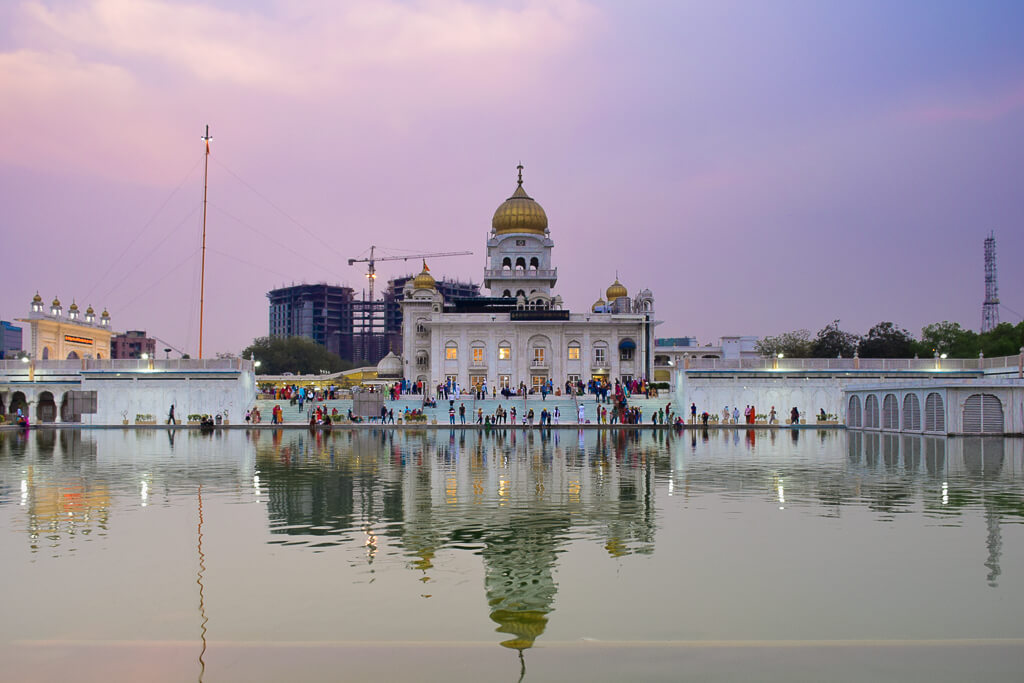
Gurudwara Bangla Sahbi
Pushkar
We took the early morning train (7 hours) to Pushkar, an interesting town and an anomaly to the rest of the places we visited in India: whilst it’s a sacred Hindu and Sikh site (no meat or alcohol can be consumed), where pilgrims come to bathe in the lake, it’s also the home of many eccentric hippies, creating a unique blend of old and new in the small town. The best way I could describe the place would be like an Indian Bali. As we have no space for shopping, I sadly had to shop with my eyes as we walked through the main market, which forms the centre of the town, nevertheless we enjoyed a relaxing afternoon enjoying the (relative) quiet, finishing with a nice dinner, which I’ll detail below. The following morning we were up early once again to do a 700 step walk up to the Savitri Devi Temple. It was made worthwhile as we were rewarded with a beautiful sunrise and a prime view to watch the local monkeys wake up.
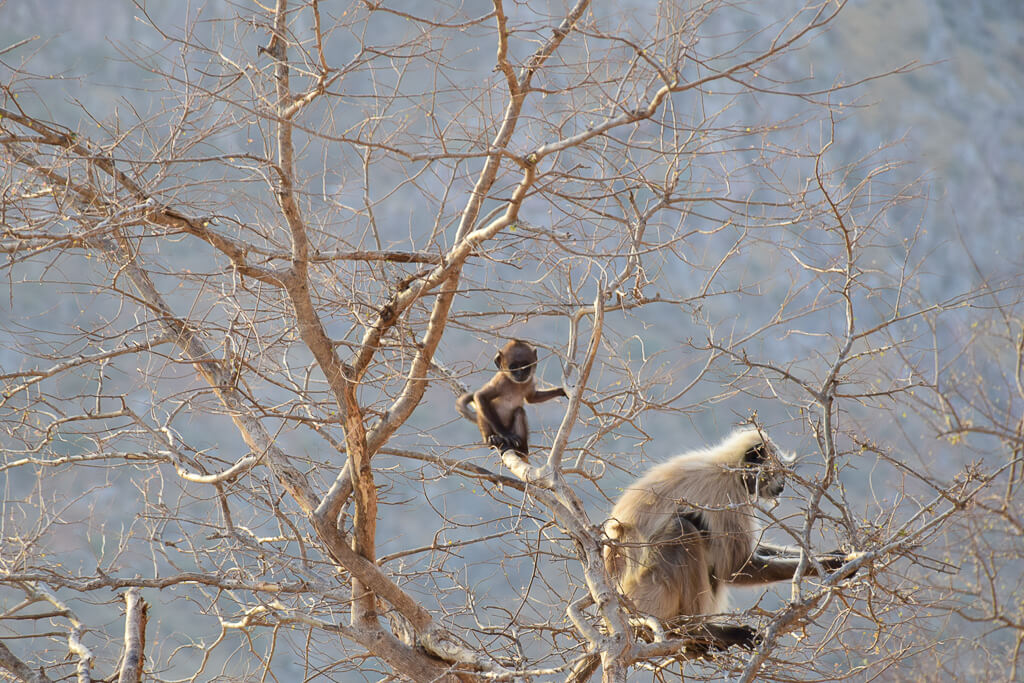
Monkeys in Pushkar
Jaipur
Our trip from Pushkar to Jaipur was certainly an interesting one - we took the “sleeper carriage” on the train (as opposed to the A/C 2nd class carriages we took previously), which is the most basic section and provides a good chance to travel like a local. And travel like a local we did; the seats are 3x3 wooden benches facing eachother and I was with a family of 5 and Fernando was with 2 others from our group and another 3 locals. Whilst only a short 2 hour ride, it was an uncomfortable experience for me as the family had their luggage across the floor where our feet would be, and the lady across from me had her bare feet on the seat next to me (for those who don’t know, I have a mild foot phobia, so this wasn’t fun).
Nevertheless, we survived with a new “local experience” under our belts (looking back, it really wasn’t that bad - there were tougher train rides to come). That afternoon we enjoyed a walk through the old town market learning about the various foods for sale. With a free night ahead of us and a late start the next morning, a group of us decided to venture out and find a pub. What started relatively tamely in a local bar, led to a drunken (very crowded) tuk tuk ride and dancing at another bar with locals.
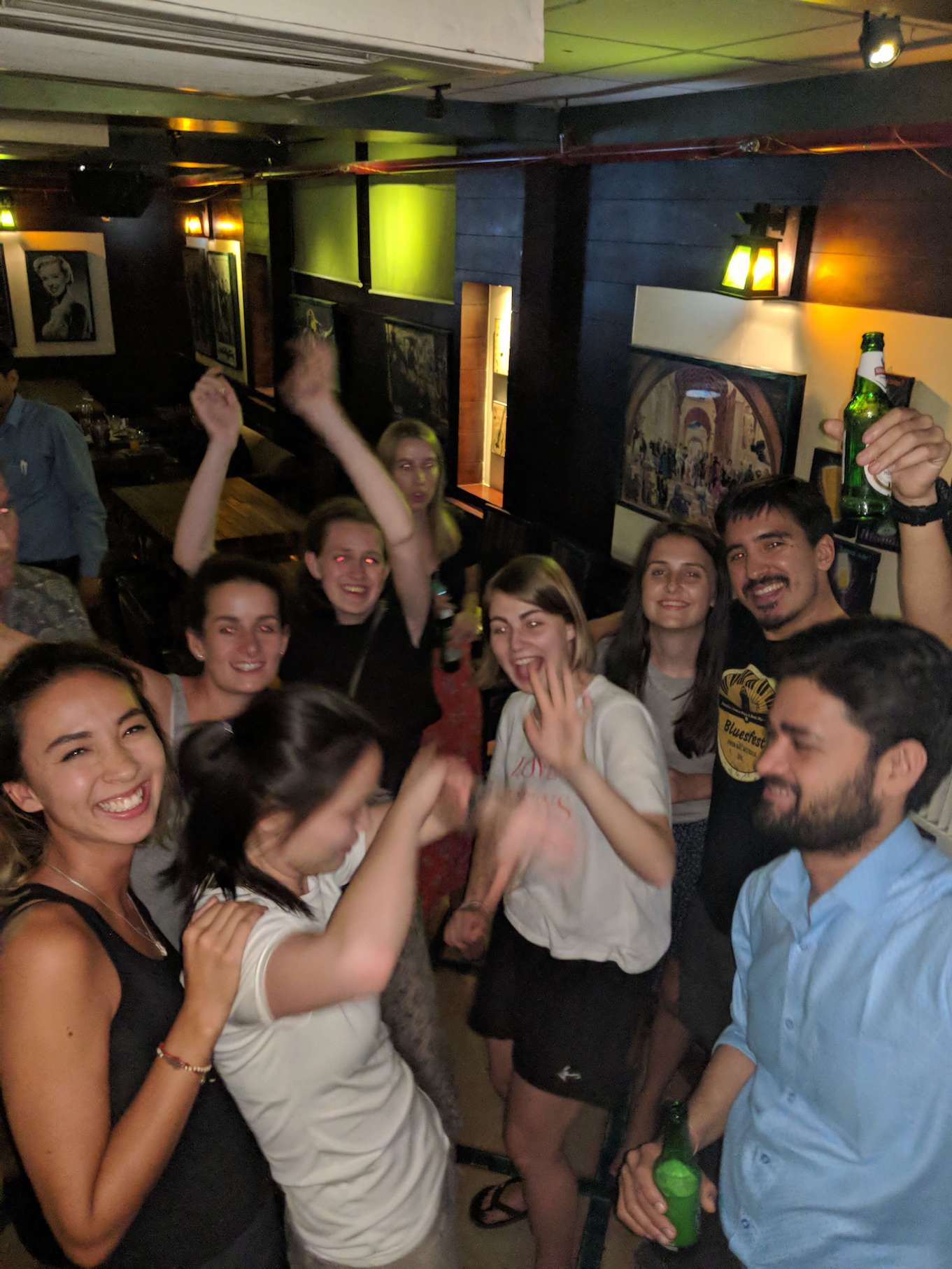
Night out in Jaipur
The following day we rode tuk tuks up to visit the Amber Fort. With more than a few of us feeling a bit delicate, the loud and bumpy ride certainly wasn’t helping. A local guide showed us around the large fort, which is filled with beautiful details and the terracotta pink, which Agra is known for. As we had seen a few forts already, the impact wasn’t as great for us but it was still very beautiful all the same.
Agra
What a feeling it is to tick one the Seven Wonders of the World off your list. Agra is home to the most beautiful love story the world has seen (according to the Brazilian musician, Jorge Ben Jor), the Taj Mahal. And it lived up to all the expectation.
The Taj Mahal is a white marble mausoleum built in 1648 by the Mughal emperor Shah Jahan in memory of his favourite wife, Mumtaz Mahal. She died while giving birth to their 14th (yes, fourteenth!) child.
Even though it was getting to low season in India, the Taj Mahal was simply packed with tourists (mainly domestic). It is estimated that it receives somewhere between 50,000 and 60,000 people every day. Still, even with all the crows around, it is just a magical place. The gardens, the building, the dome - everything is made to perfection and it’s absolutely amazing to be there.
We also visited the Agra Fort while in town, but to be honest we were a bit “forted-out” from our first week in Rajasthan, where we visited at least one fort in each city, so it wasn’t really a standout for us.
Varanasi
Varansi was a kick in our guts. Alex fell sick on the overnight train from Agra to Varanasi, which meant she was quite debilitated during our time there. Nevertheless, we went on a fascinating (and somewhat shocking) boat ride by the Ganga (Ganges) River in the afternoon.
The Ganga is sacred for the Hindus, as the legend has it that the river was created from the sweat of Lord Vishu’s feet and flowed from Heaven to Earth. Therefore, the Hindu tradition has that bathing in its water will wash away your sins, and if one is cremated and have their ashes thrown into the river, they will be saved from the cycle of birth and rebirth.
Varanasi is set at the banks of the Ganga, with lots of ghats (sacred steps), where body cremations and daily worshipping ceremonies take place in open air. While in the city, you will likely see a number of bodies being carried around to the burning grounds. From our boat ride, we could see the night ceremony (when Hindus put the Mother Ganga to sleep) as well as check out the burning ghats. It was a very confronting experience.
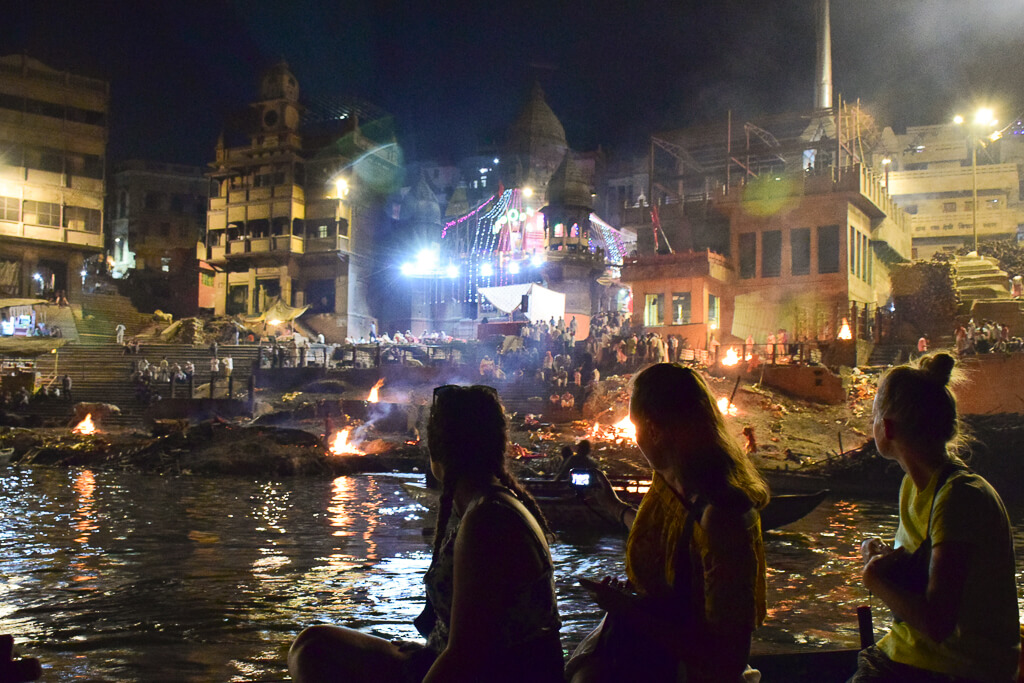
Burning Ghat in Varanasi
Varanasi also has the most hectic traffic we’ve seen in India. It is not as big as Delhi, but its narrow, winding roads with constant honking pushed our limits. We thought we were getting used to the traffic in India, but Varanasi proved us wrong. With Alex sick (including a trip to the local doctor), we took a day off and stayed at the hotel. We were exhausted and overwhelmed again.
Nepal Leg:
Lumbini > Chitwan National Park > Pokhara (28 Mar - 3 Apr)
Lumbini
Nepal came in a perfect time for us. We were getting to our limits in India, and had yet another long day of travelling (6h train ride from Varanasi to Gorakhpur and another 5h bus ride to get us across the India/Nepal border and over to Lumbini). Crossing that border and getting to Nepal was a much welcome change in pace. Our first stop was in Lumbini, the Buddha’s birthplace. This small city has a temple where Buddha was born, which you can visit and take a breather. Can’t describe how good it felt to be around trees, monks, monkeys and prayer flags. We took the time there to remind ourselves of the purpose of this trip and reconnect with our minds and bodies. We were back in shape.
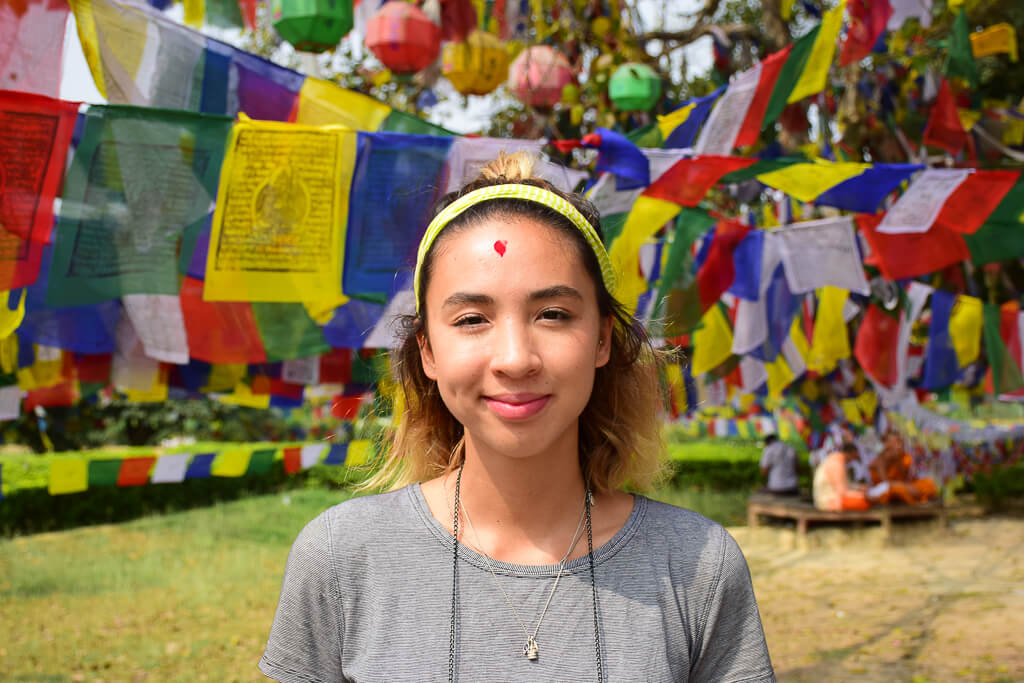
Buddha's Birthplace, Lumbini
Chitwan National Park
Another 5h on the bus got us to Chitwan district, a very rural and peaceful area of Nepal. Covered with rice fields and small villages, it is also home of the Chitwan National Park, the first national park in Nepal. We had two lovely days there, when we went on bike rides to see the sunset, walks around the village and a safari through the national park. We saw some rhinos, deers, peacocks and elephants, but also got the weather suddenly turning on us and a hot, sweaty start to the safari surprisingly became drenched and freezing after the rain.
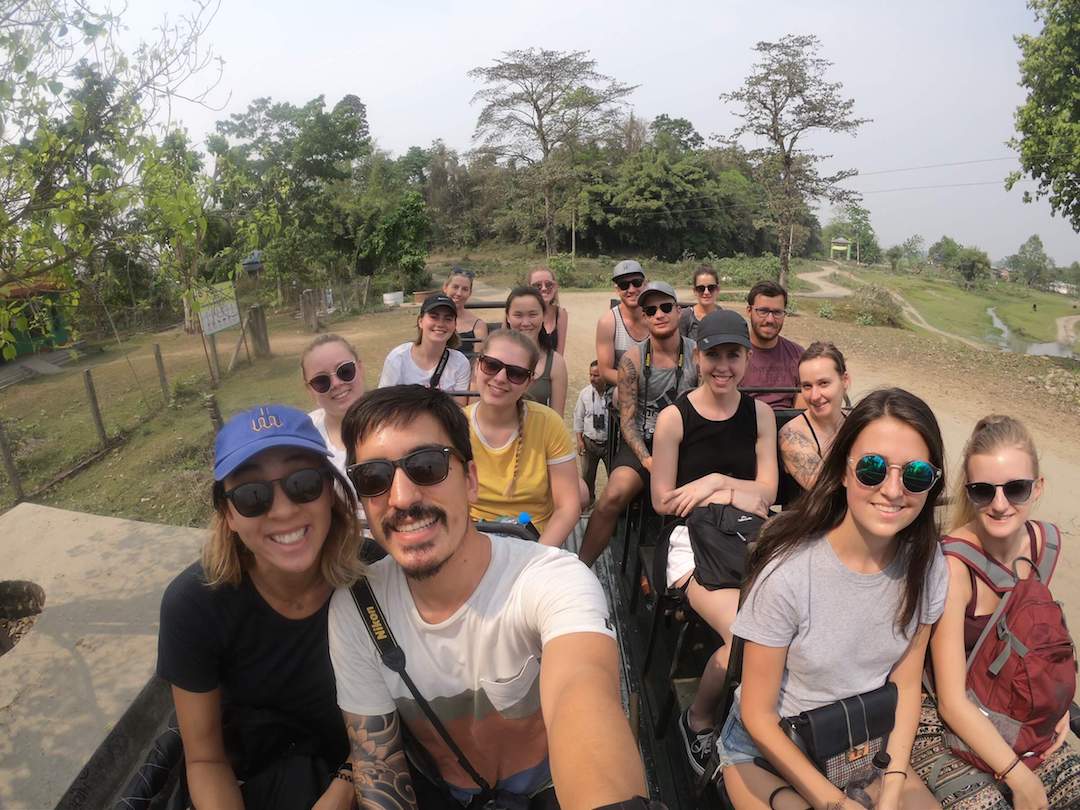
Off to the Safari, while we were all still dry
Pokhara
The drive from Chitwan National Park to Pokhara is only 150km long, but one side of the only road that connects the two cities was closed, which caused a several-kilometers-long standstill traffic jam and took us 11 hours to complete the drive (when it should have taken us 5h). Thank God for the aircon, the offline Netflix shows on our iPads and the stalls with chips on the side of the road.
Pokhara was another pleasant surprise on our tour. This beautiful city is located by the Phewa Lake and is the gateway to the Annapurna hiking circuit, a popular trail in the Himalayas. The city is very much geared towards tourism and offers a lot of western restaurants and bars, pubs, and hiking gear shops.
We had another early morning there to see the sunrise from the top of the Sarangkot village, which sits at around 1600m above sea level. This is also where - for the first time since we left home - we stayed at the same city for more than 2 nights. Yes, we could unpack our bags make ourselves at home (at least for a little longer).

Sunrise over Pokhara
This tour was another amazing experience at the start of our trip. It pushed us to our limits in India, allowed us to wind back down in Nepal, kept us on the move every second day and took a toll on our bodies and health. But it was all worthwhile. The best thing that came out of it was to be able to experience all these places with our newly made friends, who we will hopefully see again when/if we make our way to their hometowns.
This tour was also meant to take us from Pokhara to Kathmandu, but we finished it one day early and stayed in Pokhara. From here, we will start our 10-day long hike to the Annapurna Base Camp. Annapurna is the second most famous hike in Nepal (only after the Everest), and the Base Camp is situated 4,130m above sea level. Let the next adventure begin, and may we be safe (and strong!) throughout.
Check our Flickr album for this tour:

TRIP DETAILS
- DELHI: Bikanervala (a chain in Delhi) - this was a lifesaver for us; clean, English menus (but still a place for locals) and really good dosa! We dined here 3 times in a row.
- PUSHKAR: Cafe Nature’s Blessing: a very small, simple place that serves really simple, clean meals free from the heavy spices and flavours that is in Indian food. It’s all vegetarian (no meat can be consumed in Pushkar) and not spicy at all. It was a really good, healthy break from the heavy foods we had been eating. Great juices too.
- JAIPUR: 100% Rock- this is where we ended our night, dancing to cheesy songs (lots of ABBA, YMCA, Macarena) and seeing how the locals party.
- AGRA: Sheroes - a great cafe and initiative, it’s run by and supports victims of acid attacks and has a “pay what you like” model. The food was simple but good and there was free WIFI.
- VARANASI: Blue Lassi - our guide took us to this little lassi shop, where they have a ridiculous number of flavours to choose from. We sampled the Guava Lassi which was delish.


